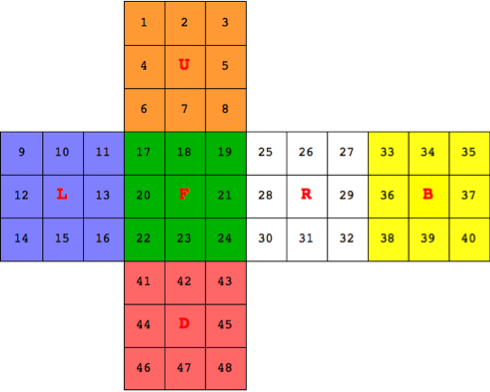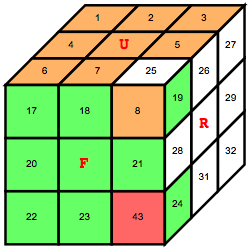目次へ
GAPを用いたRubik's Cube 解法表示ソフトについて 田崎 拓馬、藤本 光史 著 について Mathematicaを使って翻訳を試みた。
各面の表示を次のようにした。

Mathematica のコード
(* Mathematica code *)
SetDirectory[NotebookDirectory[]];
<< PlotRubiksCube2.m
Names["PlotRubiksCube`*"]
⇒ {"PlotCube", "PlotCube3D"}
(* *)
rotate[p_, rot_] := p[[#]] & /@ Permute[Range[48], rot]
(* *)
rotF = Cycles[{{17,19,24,22},{18,21,23,20},{6,25,43,16},{7,28,42,13},{8,30,41,11}}];
rotB = Cycles[{{33,35,40,38},{34,37,39,36},{3,9,46,32},{2,12,47,29},{1,14,48,27}}];
rotL = Cycles[{{9,11,16,14},{10,13,15,12},{1,17,41,40},{4,20,44,37},{6,22,46,35}}];
rotR = Cycles[{{25,27,32,30},{26,29,31,28},{3,38,43,19},{5,36,45,21},{8,33,48,24}}];
rotU = Cycles[{{1,3,8,6},{2,5,7,4},{9,33,25,17},{10,34,26,18},{11,35,27,19}}];
rotD = Cycles[{{41,43,48,46},{42,45,47,44},{14,22,30,38},{15,23,31,39},{16,24,32,40}}];
cube = PermutationGroup[{rotF, rotB, rotR, rotL, rotU, rotD}];
GroupOrder[cube]
⇒ 43252003274489856000
FactorInteger[GroupOrder[cube]]
⇒ {{2, 27}, {3, 14}, {5, 3}, {7, 2}, {11, 1}}
(* *)
rotSet = {rotF, rotB, rotR, rotL, rotU, rotD};
ruleRotate = {1 -> rotSet[[1]], 2 -> rotSet[[2]], 3 -> rotSet[[3]],
4 -> rotSet[[4]], 5 -> rotSet[[5]], 6 -> rotSet[[6]],
-1 -> InversePermutation[rotSet[[1]]], -2 -> InversePermutation[rotSet[[2]]],
-3 -> InversePermutation[rotSet[[3]]], -4 -> InversePermutation[rotSet[[4]]],
-5 -> InversePermutation[rotSet[[5]]], -6 -> InversePermutation[rotSet[[6]]]};
rules = {"f"->1,"b"->2,"r"->3,"l"->4,"u"->5,"d"->6,"f^-1"->-1,
"b^-1"->-2,"r^-1"->-3,"l^-1"->-4,"u^-1"->-5,"d^-1"->-6};
rules2 = {"f^2"->{1, 1},"r^2"->{3, 3},"f^-2"->{-1, -1},"r^-2"->{-3, -3}};
3.1 位数問題 -- 一連の操作を何回行うと元に戻るか
(* gap> Order(b*f^-1*l^-1*r^-1); *)
(* 12 *)
word = StringSplit["b*f^-1*l^-1*r^-1", "*"] /. rules
⇒ {2, -1, -4, -3}
perm = GroupElementFromWord[cube, word];
PermutationOrder[perm]
⇒ 12
3.2 メンバーシップ問題 -- 与えられた模様は実現可能か
(* gap> (8,19,25)(24,30,43) in cube; *)
(* true *)
GroupElementQ[cube, Cycles[{{8, 19, 25}, {24, 30, 43}}]]
⇒ True
(* gap> (8,19,25)(24,43,30) in cube; *)
(* false *)
GroupElementQ[cube, Cycles[{{8, 19, 25}, {24, 43, 30}}]]
⇒ false
3.3 生成元の積で表す問題 -- Rubik's cube の完成手順を求める
(8,19,25)(24,30,43) で表される状態の配置
PlotCube3D[Permute[Range[48], Cycles[{{8,19,25},{24,30,43}}]]]

(* gap> GetWordOfElements:= function ( G, GenName, x ) *)
(* > local gen, F, hom; *)
(* > F := FreeGroup( GenName ); *)
(* > gen := GeneratorsOfGroup( G ); *)
(* > hom := GroupHomomorphismByImages( F, G, GeneratorsOfGroup( F ), gen ); *)
(* > return PreImagesRepresentative( hom, x ); *)
(* > end; *)
(* function( G, GenName, x ) ... end *)
(* *)
(* gap> p:= GetWordOfElements(cube,["f","b","r","l","u","d"],(8,19,25)(24,30,43)); *)
(* f*u*l*f*l^-1*f^-1*u^-1*f^-1*r^-1*f^-1*d^-1*f*d*r*f^2*r*f*r^-1*u*f^-1*u^-1*f*r*f^-1*r^-1*f*u^-1*r*u*r^-1*f *)
base = Complement[Range[48], Join[{8,19,25},{24,30,43}]];
p = GroupElementToWord[cube, Cycles[{{8,19,25}, {24,30,43}}], GroupActionBase -> base]
⇒ {1, -3, -2, 4, 2, 3, -2, -4, 2, -3, -2, 3, -1, -3, 2, 3}
Length[p]
⇒ 16
ppp = Fold[ rotate, Range[48], p /. ruleRotate ];
PlotCube3D[ppp]

得られた手順 p の逆元が完成手順を表す。
(* gap> p^-1; *)
(* f^-1*r*u^-1*r^-1*u*f^-1*r*f*r^-1*f^-1*u*f*u^-1*r*f^-1*r^-1*f^-2*r^-1*d^-1*f^-1*d*f*r*f*u*f*l*f^-1*l^-1*u^-1*f^-1 *)
pInverse = -1*Reverse[p]
⇒ {-3, -2, 3, 1, -3, 2, 3, -2, 4, 2, -3, -2, -4, 2, 3, -1}
ppinv = Fold[ rotate, ppp, pInverse /. ruleRotate ];
PlotCube3D[ppinv]

ルービックキューブを手で回して確認するために
手順 p
n2alpha = Reverse[#] & /@ rules
⇒ {1->"f",2->"b",3 ->"r",4->"l",5->"u",6->"d",-1->"f^-1",-2->"b^-1",-3->"r^-1",-4->"l^-1",-5 ->"u^-1",-6->"d^-1"}
p
⇒ {1, -3, -2, 4, 2, 3, -2, -4, 2, -3, -2, 3, -1, -3, 2, 3}
p /. n2alpha
⇒ {"f","r^-1","b^-1","l","b","r","b^-1","l^-1","b","r^-1","b^-1","r","f^-1","r^-1","b","r"}
手順 p^-1
pInverse
⇒ {-3, -2, 3, 1, -3, 2, 3, -2, 4, 2, -3, -2, -4, 2, 3, -1}
pInverse /. n2alpha
⇒ {"r^-1","b^-1","r","f","r^-1","b","r","b^-1","l","b","r^-1","b^-1","l^-1","b","r","f^-1"}
まとめ
- GAP によるRubik's Cube の解法をMathematica に翻訳することができた。
- 手順を求める関数
GroupElementToWordのオプションGroupActionBaseの選び方によって手順の数が大きく変わる。
GroupActionBase についてドキュメントには次のように書いてある。
このアルゴリズムは与えられた基底に関連し固定群の剰余類代表の表を使う.この基底の選択が結果のワード(手順)に大きく影響する。
群論の理解を深めることが今後の課題である。